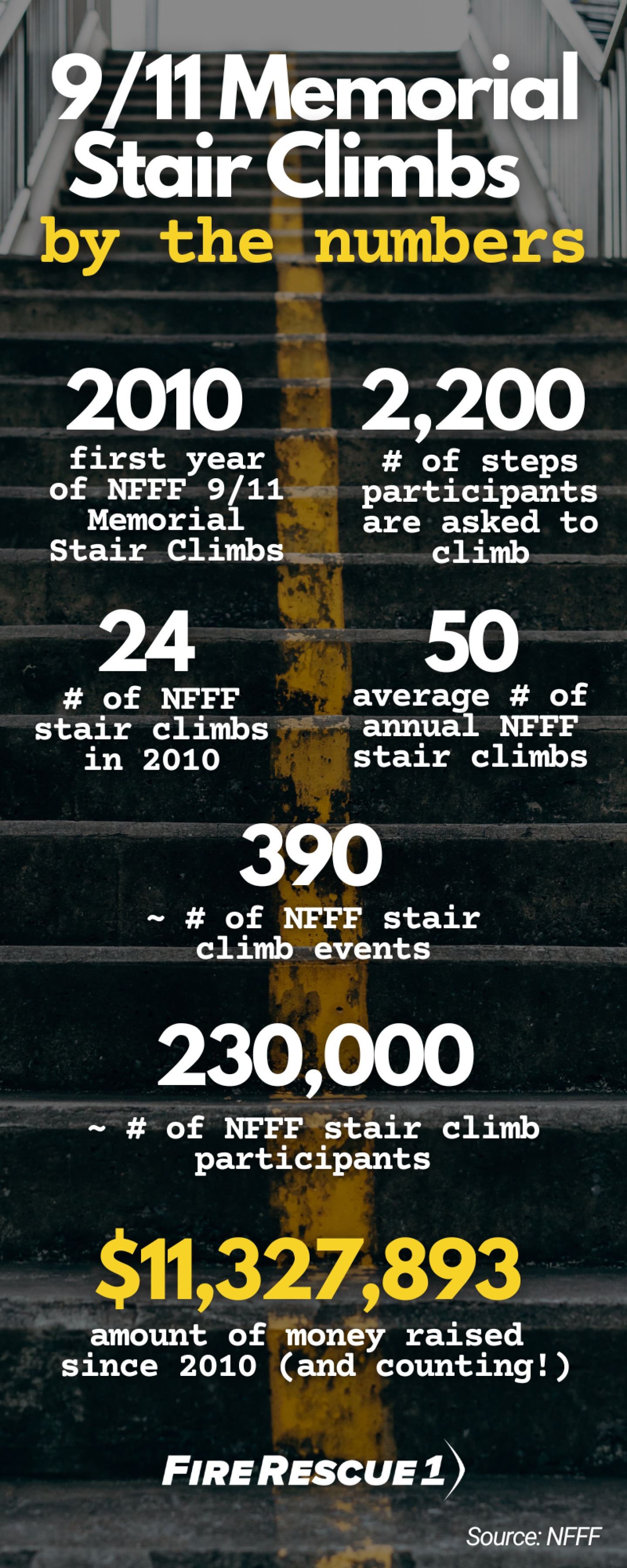Every year, thousands of first responders around the country participate in 9/11 Stair Climbs, climbing or walking the equivalent of 110 stories, or 2,200 steps, often in full firefighting gear.
It is not a race.
Each 9/11 stair climb participant is making the trek in honor of the 343 FDNY members who lost their lives on Sept. 11, 2001, as 110 stories was the height of each World Trade Center building.
Learn the history behind this enduring, active tribute to the fallen firefighters, through the following seven facts — and don’t miss the frequently asked questions.
1. 9/11 Stair Climb events raise funds for the National Fallen Firefighters Foundation
Money raised by stair climb events through registrations or donations goes toward NFFF programs benefiting the families of fallen fire service members. This includes mental health initiatives for surviving family members, outreach programs, college scholarships, summer camps for children of fallen firefighters, family retreat events and more.
2. The first stair climb was held overseas
According to the Association of Memorial Stair Climbs, the first 9/11 Memorial Stair Climb occurred in Parwan Province, Afghanistan, on Sept. 11, 2003, when Albuquerque (N.M.) Fire Department Lt. Charles Cogburn ascended a two-story building 55 times wearing body armor, a helmet and an M-4. Lt Cogburn returned home, and on the following Sept. 11 (2004), the climb was held in the United States for the first time at the 22-story Bank of Albuquerque, which firefighters climbed five times.
3. The NFFF connection was solidified in 2010
In 2005, five firefighters from the Denver Fire Department and Castle Rock Fire Department gathered at a high-rise building and climbed the equivalent of 110 flights of stairs. Five years later, the NFFF contacted the founders of the Denver event to develop a protocol to hold similar events across the country. The Nashville 9/11 Memorial Stair Climb was held on Sept. 11, 2010, and was the first to fall under the NFFF umbrella of stair climb events.
“We climb to ensure that the fallen firefighters of September 11 are never forgotten, we complete their journey through dedication, training and physical fitness,” reads the mission statement of the Denver 9/11 Memorial Stair Climb.
4. The public was invited to participate for the first time in 2009
In 2009, due to growing interest in the Denver 9/11 Stair Climb, which capped participants at 343, the Colorado 9/11 Stair Climb at Red Rock Amphitheatre was created. The event is open to the public, with attendance increasing every year. In 2016, more than 3,500 people attended the event, which raised more than $100,000 for the NFFF.
5. A template for 9/11 Stair Climb events was created in 2010
In 2010, officials from the NFFF met with the organizers of the Denver and Nashville, Tennessee, stair climbs to develop guidelines that would allow coordinators to run the event anywhere in the U.S.
6. 9/11 Stair Climbs are hosted by local volunteers
Anyone can host a stair climb in their community. While some are firefighter-led, many are organized by community leaders, local businesses and engaged citizens. For those looking to organize a stair climb even in their community, visit the NFFF website for information on how to coordinate the effort.
7. Millions have been raised for fallen firefighter families
As of 2022, more than $11 million has been raised to benefit the families of the fallen, the critical work of the NFFF and the fire service as a whole. Want to donate? Visit the NFF website.
Beyond the basic facts outlined above, many Stair Climb participants — or individuals considering signing up for an event — share the same questions to help put the Stair Climb events in context with the tragedy of 9/11.
How many floors were in the Twin Towers?
The Twin Towers each had 110 floors.
How many stairs do you climb for a 9/11 Stair Climb event?
Participants walk 2,200 steps to achieve the equivalent of one Twin Tower.
How many flights is the 9/11 stair climb?
A 9/11 Stair Climb event typically involves climbing 110 flights of stairs.
How high did firefighters climb on 9/11?
No firefighters made it all the way to the top of either World Trade Center tower before they collapsed. Here’s what we know based on reports and survivor accounts:
- North Tower (WTC 1): The plane hit between floors 93 and 99. Firefighters began climbing from the lobby, but many only reached floors between 20 and 40 before the tower collapsed at 10:28 a.m. Some units reportedly got as high as the 60th floor, but heavy debris, smoke and impassable stairwells above the impact zone prevented any higher ascent.
- South Tower (WTC 2): The plan hit between floors 77 and 85. It collapsed first, at 9:59 a.m., just 56 minutes after being struck. Some firefighters reached into the upper 20s to 30s before evacuation orders were given due to the building’s instability. A few civilians above the impact zone in the South Tower actually made it out using an intact stairwell, but no firefighters were able to reach the very top.
How hard is the 9/11 Stair Climb?
A 9/11 Stair Climb is physically and emotionally demanding. The physical challenge involves approximately 2 hours of continuous stair-climbing. What’s more, many firefighters complete the event in full firefighter gear (up to 60–70 lbs.). The climb challenges one’s cardiovascular endurance, leg strength and stamina, and mental grit. Additionally, the atmosphere is reverent, intense and often deeply personal. Climbers often wear the name or photo of an FDNY firefighter who did not survive.
How can I sign up to participate in a 9/11 Stair Climb?
Visit the NFFF website to learn more, find a climb near you, and sign up to participate.
This article, originally published in April 2021, has been updated with new information.















